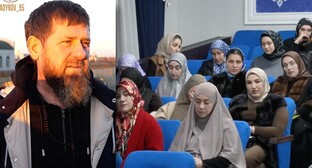12 March 2009, 22:30
North Ossetia: "RusHydro" Company floods unique necropolis
The company named "RusHydro", which is building the Zaramag Hydroelectric Power Plant (HPP), has flooded the Alaidon Necropolis, a unique monument of the Koban culture of the Caucasus, which was found in North Ossetia. The accident was reported by Ossetian archaeologist Khasanbek Chshiev.
Archaeologists have found unique historical sites, known today as Alaidon Necropolis, and a multilayered settlement of late Stone Age of Mesolithic-Neolithic Epoch named Tsmi-2, in the vicinity of the villages Nizhni Zaramag and Tsmi in the territory of North Ossetia.
"In 2006, we visited the area of the Tsmi village, not far from Zaramag, and soon detected that the builders of Zaramag HPP had disturbed several cists. There, on the bank of the Adaidon River, we made exploratory shafts, which showed the presence of a unique archaeological site of the Bronze Age," said Ossetian archaeologist Khasanbek Chshiev.
"The time, when the ancient residents settled there, in Zaramag Hollow, and opened a cemetery dates back to the 22nd century B.C., while the latest burials refer to the Scythian Age. Thus, the Adaidon Necropolis existed and functioned for more than 1500 years. This is the only known non-plundered necropolis of this type of the Bronze-Early Iron Epoch not only in North Ossetia, but in the whole South of Russia," said the archaeologist. "These findings are not just interesting - they are unique, since they cover, to a certain degree, the gap in researches of ancient Caucasian rarities, as this period - the 22nd-14th centuries B.C. - is very poorly studied in the Central Caucasus."
"Actually, it is a reference monument of the Koban culture, and, in general, of the ancient Caucasian culture. This unique necropolis with the area of about a hectare could be a tourist attraction. Unfortunately, it is all flooded now," he concluded.
The "RusHydro" managers had promised to archaeologists to start flooding the hollow by summer of 2009, however, the builders opened the gate already on January 14, and the hollow was gradually filled with water, with a threat to the objects of cultural heritage. Ossetian archaeologists immediately addressed the public with a demand to stop the works, since they threaten the non-finished archaeological excavations.
The archaeologists explain that they needed money and time to continue their researches. To get funds from the 2008 federal budget was impossible. In 2009, it appeared to be absolutely impossible.
One month after the start of flooding, the builders confessed that the drain tunnel that was in operation for more that 20 years was in emergency condition and would have failed in the next high water. To avoid a catastrophe, the builders blocked the tunnel for repairs till April. Thus, they faced the alternative: monuments of archaeology or safety of the residents of the Alagir Gorge.
The HPP builders kept saying that they hurried up wanting to give electricity to consumers, in particular, to South Ossetia. However, according to their calculations, the HPP will start supplying power only in 2012. It should be noted here that the water body not only destroys the monuments of culture, but is also a threat to the population of South Ossetia, since it is washing away the non-reinforced Trnacaucasian Highway - the only present motorway connecting the newly-proclaimed independent republic with the outer world.
Now, the archaeologists ask the "RusHydro" managers to exhibit good will and, after repairing the tunnel, to drain water from the Zaramag Hollow, giving a chance to Ossetian scientists to take invaluable relics out. So far, they got no answer from the Company and power structures of the Republic of North Ossetia-Alania (RSO-A).
Earlier, Vitaly Totrov, SEO of the OJSC "Zaramag HPPs" had stated that the archaeologists who made excavations in the Zaramag HPP vicinity signed a document allowing filling in the water basin. Nobody ever presented any papers about the need of additional archaeological excavations.
Author: Viktor Buividas Source: Especially for “Caucasian Knot”




